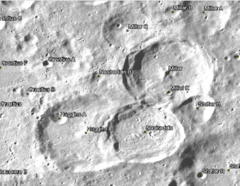Huggins (lunar crater)
|
Lunar Reconnaissance Orbiter image showing showing craters Huggins (lower left), Nasireddin (lower center, overlapping Huggins,) and Miller (upper right) | |
| Coordinates | 41°06′S 1°24′W / 41.1°S 1.4°WCoordinates: 41°06′S 1°24′W / 41.1°S 1.4°W |
|---|---|
| Diameter | 65 km |
| Depth | 3.0 km |
| Colongitude | 3° at sunrise |
| Eponym | William Huggins |
Huggins is a lunar crater that lies in the rugged southern highlands of the Moon's near side. It is named in memory of Sir William Huggins
This crater lies across the eastern rim of the larger crater Orontius. The eastern rim of Huggins is laid across in turn by the slightly smaller crater Nasireddin. Thus these three craters form a triplet of decreasing age from west to east. To the northwest of Huggins is Miller, which is attached to the northern rim of Nasireddin.
This crater has been somewhat eroded, but the surviving rim remains relatively well-defined and is only overlaid by a few tiny craterlets. The western half of the interior floor is relatively level, although a small craterlet, Huggins A, is attached to the inner wall of the northwest rim. There is a central peak formation next to the outer rampart of the intruding Nasireddin.
Satellite craters
By convention these features are identified on lunar maps by placing the letter on the side of the crater midpoint that is closest to Huggins. Huggins A lies within the Huggins crater.
| Huggins | Latitude | Longitude | Diameter |
|---|---|---|---|
| A | 40.6° S | 2.2° W | 11 km |
References
- Wood, Chuck (2006-10-26). "Moving Sideways". Lunar Photo of the Day. Archived from the original on 2007-09-27. Retrieved 2006-10-26.
- Andersson, L. E.; Whitaker, E. A. (1982). NASA Catalogue of Lunar Nomenclature. NASA RP-1097.
- Blue, Jennifer (July 25, 2007). "Gazetteer of Planetary Nomenclature". USGS. Retrieved 2007-08-05.
- Bussey, B.; Spudis, P. (2004). The Clementine Atlas of the Moon. New York: Cambridge University Press. ISBN 978-0-521-81528-4.
- Cocks, Elijah E.; Cocks, Josiah C. (1995). Who's Who on the Moon: A Biographical Dictionary of Lunar Nomenclature. Tudor Publishers. ISBN 978-0-936389-27-1.
- McDowell, Jonathan (July 15, 2007). "Lunar Nomenclature". Jonathan's Space Report. Retrieved 2007-10-24.
- Menzel, D. H.; Minnaert, M.; Levin, B.; Dollfus, A.; Bell, B. (1971). "Report on Lunar Nomenclature by the Working Group of Commission 17 of the IAU". Space Science Reviews. 12 (2): 136–186. Bibcode:1971SSRv...12..136M. doi:10.1007/BF00171763.
- Moore, Patrick (2001). On the Moon. Sterling Publishing Co. ISBN 978-0-304-35469-6.
- Price, Fred W. (1988). The Moon Observer's Handbook. Cambridge University Press. ISBN 978-0-521-33500-3.
- Rükl, Antonín (1990). Atlas of the Moon. Kalmbach Books. ISBN 978-0-913135-17-4.
- Webb, Rev. T. W. (1962). Celestial Objects for Common Telescopes (6th revised ed.). Dover. ISBN 978-0-486-20917-3.
- Whitaker, Ewen A. (1999). Mapping and Naming the Moon. Cambridge University Press. ISBN 978-0-521-62248-6.
- Wlasuk, Peter T. (2000). Observing the Moon. Springer. ISBN 978-1-85233-193-1.
